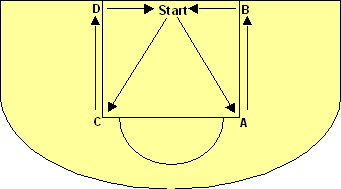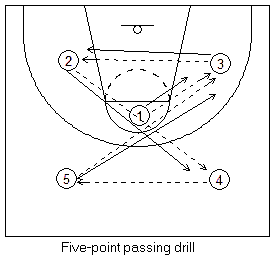In the last post, we talked about the first part of vocaulary of basketball. In this post we will explain the second part of glossary of basketball terms. We hope you find it interesting.
5. DEFENSA - DEFENSE
5.1. TÉCNICA-TÁCTICA INDIVIDUAL- INDIVIDUAL TECHNIQUE-TACTICS
- ¾ fronting on the post high/low side: Defensa en ¾ por arriba/abajo.
- Ball- you-man: Posición defensiva entre el atacante con balón en la canasta.
- Blocked Shot: Tiro taponado.
- Close out: Ajuste (acercarse) al par.
- Defence (defense): Defensa
- Defensive Rebound: Rebote defensivo.
- Defensive stance: Posición defensiva.
- Deny: Defensa en línea de pase.
- Drop steps: Paso de caída.
- Guarding: Defensa a un atacante.
- Help: Ayuda.
- Match-ups: Emparejamientos.
- Picked Off: Atrapado en el bloqueo (defensa).
- Step slides: Pasos defensivos.
- To be drawn to the ball: Moverse con el balón.
- To belly up or Body up: Conducir empujando con el cuerpo.
- To box Out: Cerrar el rebote.
- To bump, chuck, body, or ride: Contactar (choque) con el atacante para frenar su trayectoria.
- To contest a shot: Defender un tiro.
- To deflect a pass: Desviar un pase.
- To front: Defender en línea de pase con el cuerpo.
- To jump to the ball: Cambiar de defensa a jugador con balón a jugador sin balón, saltando hacia atrás y hacia la línea de pase.
- To level with the ball: Estar a la altura del balón.
- To lose sight of the ball: Perder de vista el balón.
- To make contact (for boxing out): Contactar con el defensa para cerrar el rebote.
- To move on the pass, not on the catch: Desplazarse en defensa cuando se pasa el balón, no cuando se coge.
- To move on the flight of the ball: Moverse con el pase.
- To open up: Separarse del atacante sin balón para estar en un ángulo que permita verle a él y al balón.
- To pick up an offensive foul/charge: Sacar una falta de ataque.
- To ride or Force High: Impedir que el que corta tras un bloqueo vaya a canasta o postee, guiándole con el cuerpo.
- To show/Showing: Salir (mostrarse) para frenar al jugador con balón (fintar un 2 contra 1).
- To slide: Desplazarse con pasos deslizantes en defensa.
- To stablish a help position: Colocarse en posición de ayuda.
- To steal: Robar.
- To step into the pass: Saltar a cortar el pase.
 |
Image 1. Example of "to steal" by Gus Estrella
|
5.2. TÁCTICA COLECTIVA
5.2.1. BLOQUEOS
- Blitz the pick and roll: Salto al 2 contra 1 del defensor del bloqueador en un bloqueo directo.
- Contact show: Salto para frenar a un bloqueado con balón manteniendo la defensa al bloqueador.
- To chase: Persiguir (defensa de bloqueos).
- To fight/go over: Pasar el bloqueo por arriba.
- To fight through screens: Pasar bloqueos.
- To go below: Pasar el bloqueo por debajo.
- To hedge and recover: Ayuda y recuperación en la defensa de un bloqueo directo.
- To help and recover: Ayuda y recuperación
- To lock and trail: Defender un bloqueo ( vertical) persiguiendo.
- To shoot the gap: Pasar un bloqueo vertical para negar el pase.
- To show and go: Mostrarse para frenar al jugador bloqueado y recuperar.
- To show and recover: Mostrarse y recuperar (defensa de un bloqueo).
- To slide through: Pasar el bloqueo por en medio.
- To slip the pick (defensive): Pasar el bloqueo vertical por en medio.
- To switch: Cambiar la asignación defensiva sobre jugadores.
- Up the line: Cambios en los bloqueos sucesivos.
 |
Image 2. Example of "to lock and trail" by Gus Estrella
|








